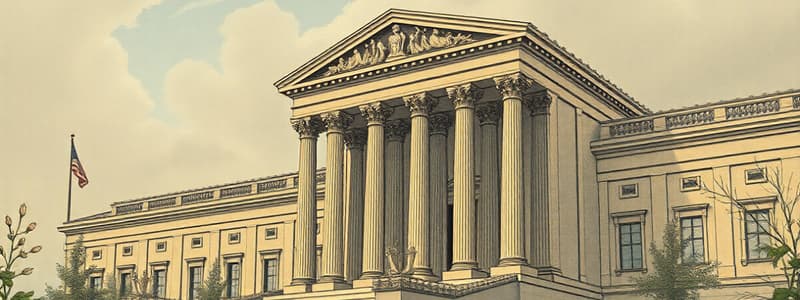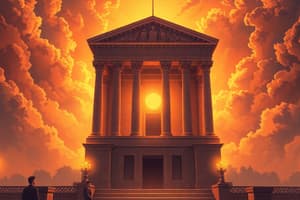Podcast
Questions and Answers
According to Article III of the U.S. Constitution, which branch of government does it define?
According to Article III of the U.S. Constitution, which branch of government does it define?
- Military Branch
- Judicial Branch (correct)
- Executive Branch
- Legislative Branch
Before the establishment of the judicial branch under the Constitution, which document governed the newly formed nation?
Before the establishment of the judicial branch under the Constitution, which document governed the newly formed nation?
- The Articles of Confederation (correct)
- The Federalist Papers
- The Declaration of Independence
- The Magna Carta
What was a primary motivation for establishing a new Constitution that included a judicial branch?
What was a primary motivation for establishing a new Constitution that included a judicial branch?
- To consolidate power within the Executive Branch.
- To streamline the process of amending laws.
- To ensure a balance of power and prevent concentration of authority. (correct)
- To reduce the influence of state governments.
During the Constitutional Convention, what power was ultimately vested in the judicial branch?
During the Constitutional Convention, what power was ultimately vested in the judicial branch?
How did Alexander Hamilton describe the judiciary in its early years?
How did Alexander Hamilton describe the judiciary in its early years?
Which factor contributes to the perception that the Supreme Court has become more political over time?
Which factor contributes to the perception that the Supreme Court has become more political over time?
Which legislative act, passed shortly after the ratification of the Constitution, played a crucial role in establishing the structure of the federal judiciary?
Which legislative act, passed shortly after the ratification of the Constitution, played a crucial role in establishing the structure of the federal judiciary?
According to Article III, Section 1, of the Constitution, where is the judicial power of the United States vested?
According to Article III, Section 1, of the Constitution, where is the judicial power of the United States vested?
What does Section 2 of Article III specify regarding the judicial power of the Supreme Court?
What does Section 2 of Article III specify regarding the judicial power of the Supreme Court?
What is required by Section 3 of Article III for a conviction of treason?
What is required by Section 3 of Article III for a conviction of treason?
What is the term length for federal judges, according to Article III?
What is the term length for federal judges, according to Article III?
What rationale did the Framers have for granting federal judges lifetime appointments?
What rationale did the Framers have for granting federal judges lifetime appointments?
Which branch of the U.S. government has the power to alter the jurisdiction of the Supreme Court?
Which branch of the U.S. government has the power to alter the jurisdiction of the Supreme Court?
Besides altering the Court's jurisdiction, what other checks does Congress have on the judiciary?
Besides altering the Court's jurisdiction, what other checks does Congress have on the judiciary?
Who is responsible for appointing all federal judges?
Who is responsible for appointing all federal judges?
The power of judicial review, which allows courts to review the actions of other government branches is:
The power of judicial review, which allows courts to review the actions of other government branches is:
Which statement reflects the Anti-Federalists' view of the Supreme Court?
Which statement reflects the Anti-Federalists' view of the Supreme Court?
Before the Constitution, most of the powers of law fell under:
Before the Constitution, most of the powers of law fell under:
The creation of the federal judicial branch has:
The creation of the federal judicial branch has:
When moving the national government to the district of Columbia, what happened?
When moving the national government to the district of Columbia, what happened?
Flashcards
Article 3 of the Constitution
Article 3 of the Constitution
Article 3 of the US Constitution outlines the provisions and powers of the judicial branch.
Role of the Judicial Branch
Role of the Judicial Branch
The judicial branch interprets laws and ensures they are enforced.
Why Create the Judicial Branch?
Why Create the Judicial Branch?
The judicial branch was created to balance power, preventing any single branch from becoming too dominant.
Judiciary: 'Least Dangerous Branch'
Judiciary: 'Least Dangerous Branch'
Signup and view all the flashcards
Judicial Nominations
Judicial Nominations
Signup and view all the flashcards
Creation of the Federal Judiciary
Creation of the Federal Judiciary
Signup and view all the flashcards
Appointment of Federal Judges
Appointment of Federal Judges
Signup and view all the flashcards
Framer's View of Judiciary
Framer's View of Judiciary
Signup and view all the flashcards
Judiciary Act of 1789
Judiciary Act of 1789
Signup and view all the flashcards
Judicial Review
Judicial Review
Signup and view all the flashcards
Article III, Section 1
Article III, Section 1
Signup and view all the flashcards
Checks on Supreme Court
Checks on Supreme Court
Signup and view all the flashcards
Judicial Life Tenure
Judicial Life Tenure
Signup and view all the flashcards
Article III, Section 3
Article III, Section 3
Signup and view all the flashcards
Study Notes
- Article 3 of the US Constitution defines the powers of the judicial branch.
- The judicial branch interprets and enforces laws, balancing the other two branches of government
Creation of the Judiciary Branch
- Before the Articles of Confederation, there was no judicial branch
- The absence of the judicial branch motivated the creation of the US Constitution.
- The framers of the Constitution strategically distributed power by vesting the power of interpreting and making decisions based on the law within the judicial branch of government.
- The framers avoided placing all power in either the presidential nor the Congress by strategically distributing the power
Alexander Hamilton
- Alexander Hamilton urged support for the U.S. Constitution in 1787
- He believed that the judiciary would be the weakest of the three departments of government.
- During the move of the national government to the District of Columbia, space for the justices of the Supreme Court was forgotten.
Supreme court
- The role of courts, especially the Supreme Court, differs significantly from what was envisioned in 1788.
- Elected presidents nominate judges to federal courts and justices to the Supreme Court, which can advance personal politics.
- The selection process and how cases are heard by the Supreme Court is political.
- Interest groups seek test cases to advance their policy positions and the U.S. government, through the Department of Justice, seeks to advance its version of the public interest in court.
- The framers devoted little time to the writing or content of Article III and therefore the creation of the judicial branch.
Framers
- The Framers believed that a federal judiciary posed little threat of tyranny compared to the other two branches.
- There were arguments about the Constitution during the ratification process.
- Anti-Federalists feared that the ability to interpret "the supreme law of the land" would give the Supreme Court too much power.
- The Framers debated the necessity of federal courts below the Supreme Court level. Some argued for state courts handling all cases, with appeals to the Supreme Court, others advocated for a system of federal courts.
Constitution Article III, section 1
- Article III, Section 1, vests judicial power in "one supreme Court, and in such inferior Courts as the Congress may from time to time ordain and establish."
- A compromise left the final choice to Congress due to arguments between two sides
- Section 1 authorize Congress the authority to establish other courts as it saw fit
- Section 2 specifies the judicial power of the Supreme Court
- Section 2 includes the Court's original and appellate jurisdiction.
- Section 2 specifies that all federal crimes, except impeachment cases, are tried by jury in the state where the crime occurred.
- Section 3 defines treason and mandates that at least two witnesses appear in such cases.
- Although it is the duty of the chief justice of the United States to preside over presidential impeachments, this is not mentioned in Article III, instead Article I, section 3, notes in discussing impeachment, “When the President of the United States is tried, the Chief Justice shall preside.”
Judiciary Act of 1789
- The Judiciary Act of 1789 established the lower federal courts and other functions of the federal judiciary.
- The Act provided a charter for the federal judicial system.
- The act specified the jurisdiction and powers of district and circuit courts.
- The act defined qualifications and authority of federal judges, district attorneys, court clerks, U.S. Marshals, and Deputy Marshals.
Judicial Review
- Judicial review, which gives the courts the power to review acts of other branches of government and the states, is not written in the Constitution.
- It was resolved in the Marbury v. Madison (1803) case.
Federal Court Composition
- The federal court system includes specialized courts, district courts, courts of appeals, and the Supreme Court, which is the ultimate authority on all federal law.
- All appointments to the federal district courts, courts of appeals, and the Supreme Court are made by the president and are subject to Senate confirmation.
- Only a few of the millions of cases filed in courts around the United States each year reach the Supreme Court through the appellate process.
- Judicial philosophy and decision-making involve judicial decision-making based on legal and extra-legal factors.
Judges Lifetime Tenure
- Article III states that judges "hold their office during good behavior," meaning they have a lifetime appointment under limited circumstances.
- Lifetime tenure was agreed upon, so framers did not want justices/federal judges subject to politics, the public, or politicians.
Checks on Power
- Checks on the judiciary's power were included in the Constitution.
- The Constitituion gives congress the authority to alter the Court’s jurisdiction.
- Congress can propose constitutional amendments to reverse judicial decisions and can impeach and remove federal judges.
- The president, with the Senate's advice and consent, appoints all federal judges.
Studying That Suits You
Use AI to generate personalized quizzes and flashcards to suit your learning preferences.




